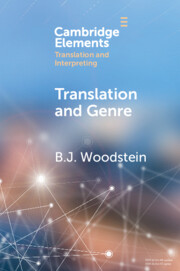References
Aaltonen, S. (2000). Time-Sharing on Stage. Clevedon: Multilingual Matters.
Alvstad, C. (2018). Children’s Literature. In Washbourne, K. and Van Wyke, B., eds., The Routledge Handbook of Literary Translation. Abingdon, UK: Routledge, pp. 159–80.
Angles, J. (2017). Queer Translation/Translating Queer in Japan. In Epstein, B. J. and Gillett, R., eds., Queer in Translation. Abingdon, UK: Routledge, pp. 87–103.
Apter, E. (2007). Taskography: Translation as Genre of Literary Labor. Publications of the Modern Language Association, 122(5), pp. 1403–15.
Baer, B. J. (2017). A Poetics of Evasion: The Queer Translations of Aleksei Apukhtin. In Epstein, B. J. and Gillett, R., eds., Queer in Translation. Abingdon, UK: Routledge, pp. 51–63.
Bauer, H., ed. (2015). Sexology and Translation: Cultural and Scientific Encounters Across the Modern World. Philadelphia, PA: Temple University Press.
Bawarshi, A. S. and Reiff, M. J. (2010). Genre: An Introduction to History, Theory, Research, and Pedagogy. Anderson, SC: Parlor Press.
Beebee, T. O. (1994). The Ideology of Genre. University Park: The Pennsylvania State University Press.
Bennett, A. and Royle, R. (1960/2014). An Introduction to Literature, Criticism and Theory, 4th ed. Abingdon, UK: Routledge.
Bianchi, D. (2018). Dangerous Visions? The Circulation and Translation of Women’s Crime Fiction and Science Fiction. Perspectives, 26(6), pp. 901–15.
Bloom, H. (1994). The Western Canon: The Books and School of the Ages. New York: Harcourt Brace.
Bloom, P. (2010). How Pleasure Works. London: Random House.
Boase-Beier, J. (2019). Translation and Style, 2nd ed. London: Taylor & Francis.
Bosch, E. (2018). Wordless Picturebooks. In Kümmerling-Meibauer, B., ed., The Routledge Companion to Picturebooks. Abingdon, UK: Routledge, pp. 191–200.
Bould, M. and Vint, S. (2011). The Routledge Concise History of Science Fiction. Abingdon, UK: Routledge.
Bradford, R. (2015). Crime Fiction: A Very Short Introduction. Oxford: Oxford University Press.
Brennan, S. (2016). The Argonauts by Maggie Nelson (review). Kennedy Institute of Ethics Journal, 26(3), pp. 19–22.
Brodie, G. (2017). The Translator on Stage. London: Bloomsbury.
Brodie, G. (2018). Performing the Literal: Translating Chekhov’s Seagull for the Stage. In J. Boase-Beier, L. Fisher, H. Furukawa, eds., The Palgrave Handbook of Literary Translation. London: Palgrave, pp. 209–29. https://doi.org/10.1007/978-3-319-75753-7_11. Brumme, J. (2014). The Narrator’s Voice in Translation: What Remains from a Linguistic Experiment in Wolf Hass’s Brenner Detective Novels. In Cadera, S. M. and Pintarić, A. P., eds., The Voices of Suspense and Their Translation in Thrillers. Amsterdam: Rodopi, pp. 161–76.
Burton, W. M. (2010). Inverting the Text: A Proposed Queer Translation Praxis. In Other Words: Translating Queers/Queering Translation, B.J. Epstein, ed., 36, pp. 54–68.
Cadera, S. M. and Pintarić, A. P., eds. (2014). The Voices of Suspense and Their Translation in Thrillers. Amsterdam: Rodopi .
Carlson, M. (2014). Theatre: A Very Short Introduction. Oxford: Oxford University Press.
Carroll, L. (1865/2001). The Annotated Alice. London: Penguin.
Castro, O. and Ergun, E. (2018). Translation and Feminism. In Evans, J. and Fernandez, F., eds., The Routledge Handbook of Translation and Politics. Abingdon, UK: Routledge, pp. 125–44.
Collins, K. (2019). The Morbidity of Maternity: Radical Receptivity in Maggie Nelson’s The Argonauts. Criticism, 61(3), pp. 311–34.
Conacher, A. (2006). Susanne de Lotbinière-Harwood: Totally Between. In Whitfield, A., ed. Writing Between the Lines. Waterloo, ON: Wilfrid Laurier University Press, pp. 245–66.
Dimock, W. C. (2007). Introduction: Genres as Fields of Knowledge. Publications of the Modern Language Association, 122(5), pp. 1377–88.
Edgar, D. (2009). How Plays Work. London: Nick Hern Books.
Epstein, B. J., ed. (2010). In Other Words: Translating Queers/Queering Translation, 36.
Epstein, B. J. (2011). Girl with the Dragon Translation: Translating Thrillers and Thrilling Translations. FIT XIX Congress Proceedings.
Epstein, B. J. (2012) Translating Expressive Language in Children’s Literature. Bern: Peter Lang.
Epstein, B. J. (2013). Are the Kids All Right? Representations of LGBTQ Characters in Children’s and Young Adult Literature. Bristol: Hammer On Press.
Epstein, B. J. (2017). Eradicalisation: Eradicating the Queer in Children’s Literature. In Epstein, B. J. and Gillett, R., eds., Queer in Translation. Abingdon, UK: Routledge, pp. 118–28.
Epstein, B. J. and Gillett, R., eds. (2017). Queer in Translation. Abingdon, UK: Routledge.
Evans, A. B. (2017). The Beginnings: Early Forms of Science Fiction. In Luckhurst, R., ed., Science Fiction: A Literary History. London: The British Library, pp. 11–43.
Feral, A. L. (2011). Sexuality and Femininity in Translated Chick Texts. In von Flotow, L., ed., Translating Women. Ottawa: University of Ottawa Press, pp. 183–202.
Flood, A. (2021a). Winterson on ‘Wimmins’ Fiction. The Guardian, 12 June.
Frow, J. (2006). Genre. Abingdon: Routledge.
Gao, J. and Hua, Y. (2021). On the English Translation Strategy of Science Fiction from Humboldt’s Linguistic Worldview – Taking the English Translation of Three-Body Problem as an Example. Theory and Practice in Language Studies, 11(2), pp. 186–90.
Gardiner, J. K. (1981). On Female Identity and Writing by Women. Critical Inquiry, 8(2), pp. 347–61.
Gledhill, C. and Ball, V. (1997/2013). Genre and Gender: The Case of Soap Opera. In Hall, S., Evans, J. and Nixon, S., eds., Representation, 2nd ed. London: Sage, pp. 335–84.
Harvey, K. (1998). Translating Camp Talk. The Translator, 4(2), pp. 295–320.
Hunt, P. (2009). Instruction and Delight. In Maybin, J. and Watson, N. J., eds., Children’s Literature: Approaches and Territories. Hampshire: Palgrave Macmillan, pp. 12–25.
James, P. D. (2009). Talking about Detective Fiction. Oxford: Bodleian Library.
Klingberg, G. (1977). Att Översätta Barn- och Ungdomsböcker [Translating Children’s and Young Adults’ Books]. Gothenburg, Sweden: Pedagogiska institutionen, Lärarhögskolan i Göteborg.
Klingberg, G. (2008). Facets of Children’s Literature Research. Stockholm: Swedish Institute for Children’s Books.
Kümmerling-Meibauer, B., ed. (2018). The Routledge Companion to Picturebooks. Abingdon, UK: Routledge.
Lathey, G., ed. (2006). The Translation of Children’s Literature. Clevedon: Multilingual Matters.
Lathey, G. (2015). Translating Children’s Literature. Abingdon, UK: Routledge.
Leone, L. (2014). Reconstructing Suspense: Borges Translates Faulkner’s The Wild Palms. In Cadera, S. M. and Pintarić, A. P., eds., The Voices of Suspense and Their Translation in Thrillers. Rodopi: Amsterdam, pp. 77–91.
Lew, E. S. (2010). ‘This Is My Girlfriend, Linda’: Translating Queer Relationships in Film. In Other Words: Translating Queers/Queering Translation, B.J. Epstein, ed., 36, pp. 3–22.
Linder, D. (2014). Chester Himes’s For Love of Imabelle in Spanish: Josep Elias’s ‘Absurdly’ Overcompensated Slang. In Cadera, S. M. and Pintarić, A. P., eds., The Voices of Suspense and Their Translation in Thrillers. Rodopi: Amsterdam, pp. 95–110.
Litaudon, M.-P. (2018). ABC Books. In Kümmerling-Meibauer, B., ed., The Routledge Companion to Picturebooks. Abingdon, UK: Routledge, pp. 169–79.
Luckhurst, R. (2017). Introduction. In Luckhurst, R., ed., Science Fiction: A Literary History. London: The British Library, pp. 8–10.
Luckhurst, R. ed. (2017). Science Fiction: A Literary History. London: The British Library.
Maier, C. (1998). Issues in the Practice of Translating Women’s Fiction. Bulletin of Hispanic Studies, 75(1), pp. 95–108.
Mandel, E. (1984). Delightful Murder. London: Pluto Press.
Massardier-Kenney, F. (1997). Towards a Redefinition of Feminist Translation Practice. The Translator, 3(1), pp. 55–69.
Moffett, M. W. (2013). Human Identity and the Evolution of Societies. Human Nature, 24(3), pp. 219–67.
Munday, J. (2001/2008). Introducing Translation Studies, 2nd ed. Abingdon, UK: Routledge.
Naro, G. and Naro, M. W. (2014). Reducing Distance Between Characters, Narrator and Reader. Fictive Dialogue in Steinfest’s Nervöse Fische and Its Translation into French. In Cadera, S. M. and Pintarić, A. P., eds., The Voices of Suspense and Their Translation in Thrillers. Rodopi: Amsterdam, pp. 177–92.
Nodelman, P. (1988). Words about Pictures. Athens, Georgia: University of Georgia Press,
Nord, C. (1988). Text Analysis in Translation, 2nd ed. Amsterdam: Rodopi.
Nord, C. (1997). Translating as a Purposeful Activity: Functionalist Approaches Explained. Manchester: St. Jerome.
Noir, Nordic. (2010). BBC 4 Time Shift. 21 December.
Oittinen, R. (1993). I am Me – I am Other. On the Dialogics of Translating for Children. Tampere, Finland: University of Tampere.
Oittinen, R. (2000). Translating for Children. New York: Garland.
Oittinen, R. (2018). Picturebooks and Translation. In Kümmerling-Meibauer, B., ed., The Routledge Companion to Picturebooks. Abingdon, UK: Routledge, pp. 463–70.
Owen, S. (2007). Genres in Motion. PMLA, 122(5), pp. 1389–93.
Palekar, S. (2017). Re-Mapping Translation. In Epstein, B. J. and Gillett, R., eds., Queer in Translation. Abingdon, UK: Routledge, pp. 8–24.
Palmer, J. (1979). Thrillers. London: Edward Arnold.
Patton, C. and Sanchez-Eppler, B., eds. (2000). Queer Diasporas. Durham, NC: Duke University Press.
Peghinelli, A. (2012). Theatre Translation as Collaboration: A Case in Point in British Contemporary Drama. Journal for Communication and Culture, 2(1), pp. 20–30.
Porter, D. (1981). The Pursuit of Crime. New Haven: Yale University Press.
Reiβ, K. (1971/2000). Type, Kind and Individuality of Text: Decision Making in Translation. Transl. Susan Kitron. In L. Venuti, ed., The Translation Studies Reader. Abingdon, UK: Routledge, pp. 168–79.
Reynolds, K. (2011). Children’s Literature: A Very Short Introduction. Oxford: Oxford University Press.
Robinson, L. S. (1983). Treason Our Text: Feminist Challenges to the Literary Canon. Tulsa Studies in Women’s Literature, 2(1), pp. 83–98.
Rose, E. (2017). Revealing and Concealing the Masquerade of Translation and Gender: Double-Crossing the Test and the Body. In Epstein, B. J. and Gillett, R., eds., Queer in Translation. Abingdon, UK: Routledge, pp. 37–50.
Rosenheim, Jr., E. W. (1961). What Happens in Literature. Chicago: University of Chicago Press.
Sánchez, J. L. A. (2014). ‘Se So’ Sparati a via Merulana’: Achieving Linguistic Variation and Oral Discourse in the French and Spanish Versions of Quer pasticciaccio brutto de via Merulana (chapter 1). In Cadera, S. M. and Pintarić, A. P., eds., The Voices of Suspense and Their Translation in Thrillers. Rodopi: Amsterdam, pp. 111–26.
Seago, K. (2014). Red Herrings and Other Misdirection in Translation. In Cadera, S. M. and Pintarić, A. P., eds., The Voices of Suspense and Their Translation in Thrillers. Rodopi: Amsterdam, pp. 207–20.
Sedgwick, E. K. (1993). Tendencies. Durham, NC: Duke University Press.
Seed, D. (2011). Science Fiction: A Very Short Introduction. Oxford: Oxford University Press.
Shavit, Z. (2006). Translation of Children’s Literature. In Lathey, G., ed., The Translation of Children’s Literature. Clevedon: Multilingual Matters, pp. 25–40.
Sieghart, M. A. (2021). From Austen to Atwood, the Brontës to Booker Winners … Why Do So Few Men Read Books by Women? The Guardian, 10 July, p. 25.
Simon, S. (1996). Gender in Translation: Cultural Identity and the Politics of Transmission. Abingdon, UK: Routledge.
Škifić, S. and Petković, R. (2014). Stylistic and linguistic Creation of Suspense in Quentin Tarantino’s Pulp Fiction and Reservoir Dogs. In Cadera, S. M. and Pintarić, A. P., eds., The Voices of Suspense and Their Translation in Thrillers. Rodopi: Amsterdam, pp. 47–59.
Spivak, G. C. (1992/2004). The Politics of Translation. In Venuti, L., ed., The Translation Studies Reader, 2nd ed. Abingdon, UK: Routledge, pp. 369–88.
Strunk Jr., W. and White, E. B. (1935/2000). The Elements of Style, 4th ed. Boston: Allyn and Bacon.
Suh, J. C. (2002). Compounding Issues on the Translation of Drama/Theatre Texts. Meta, 47(1), pp. 51–7.
Sullivan, N. (2003/2011). A Critical Introduction to Queer Theory. Edinburgh: Edinburgh University Press.
Van Coillie, J. and Verschueren, W. P. eds. (2006). Children’s Literature in Translation: Challenges and Strategies. Manchester: St. Jerome.
Venuti, L. ed. (1995). The Translator’s Invisibility. New York: Routledge.
Venuti, L. ed. (2004). The Translation Studies Reader, 2nd ed. Abingdon, UK: Routledge.
Vickery, A. (2020). Revaluing Memoir and Rebuilding Mothership in Maggie Nelson’s The Argonauts. Australian Literary Studies, 35(1), pp. 1–15.
von Flotow, L. (1991). Feminist Translation: Contexts, Practices and Theories. TTR, 4(2), pp. 69–84.
von Flotow, L. (1997). Translation and Gender: Translation in the Era of Feminism. Manchester: St. Jerome.
von Flotow, L. ed. (2011). Translating Women. Ottawa: University of Ottawa Press.
Wallmach, K. (2006). Feminist Translation Strategies: Different or Derived? Journal of Literary Studies, 22(1–2), pp. 1–26.
Wechsler, R. (1998). Performing Without a Stage. North Haven: Catbird Press.
Willett, E. A. R. (2016). Feminist Choices of Early Women Bible Translators. Open Theology, 2, pp. 400–4.
Wood, A. (2015). Making the Invisible Visible: Lesbian Romance Comics for Women. Feminist Studies, 41(2), pp. 293–334.
Woolf, V. (1929/2008). A Room of One’s Own. Oxford: Oxford University Press.
Worthington, H. (2010). Key Concepts in Crime Fiction. London: Palgrave.
Wu, Y. (2020). Globalization, Science Fiction and the China Story: Translation, Dissemination and Reception of Liu Cixin’s Works across the Globe. Critical Arts, 34(6), pp. 56–70.
Zatlin, P. (2006). Theatrical Translation and Film Adaptation. Clevedon: Multilingual Matters.



